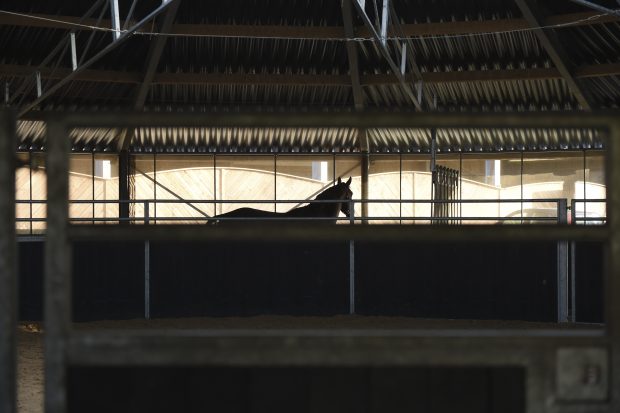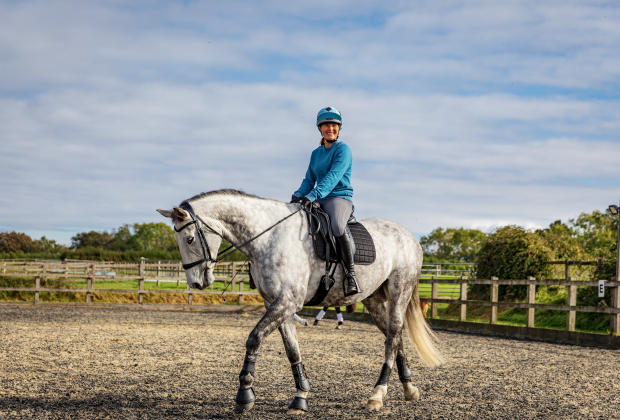If you are looking to keep your horse in the best possible health so they can perform optimally, treatments by a qualified equine therapist are only the beginning — follow them up with targeted strengthening exercises at home and you’ll be amazed with the results. Veterinary physiotherapist Hayley Marsh suggests the following pole exercises for horses, which are designed to help strengthen their core, to do at home in between treatments.
How pole exercises for horses work
Polework for horses can increase the range of motion of the horse’s limbs and joints, engage the hindquarters, increase stride length and core stability, and improve balance and proprioception (the sense of position and movement). The following exercises can be done under saddle, in-hand, on the lunge or on long-reins. NB: If your horse is coming back into work following an injury, or if you have any concerns about your horse’s physical state, we recommend you speak to your vet or physio before adding these exercises into your horse’s work.
Three pole exercises for horses to strengthen their core
1. Raised poles
Set out six poles in a line, spaced so that there is one footfall between each pole, and work through them in walk first, followed by trot once you’ve amended the distance. Next, raise alternate ends of the poles (beginning with one pole at a time for inexperienced horses), starting with just a few inches in height, to increase the range of motion in the joints. On approach, make sure that the horse is balanced and straight, and let him find his own way through the poles. Don’t hold him together. Once the horse is performing this exercise well you can gradually increase the height of the poles, but they should not exceed about a foot on one side, with the other end resting on the ground.
2. The maze
Set up a maze, as in the video. Walk through in a forward, balanced walk. As you turn each corner, open your inside hand to encourage the horse to bend through his body in the direction of travel and place your inside leg slightly behind the girth, encouraging him to step under and cross over with his hindlegs. If you are doing this exercise in-hand, then use your body positioning, line and stick to encourage the horse to bend to the inside and step under with the hindleg. Once set up, you can also use this exercise to walk and trot over the poles (see arrows on diagram below).

3. Fan of poles
Set out five poles in a fan shape with a foot’s width between the poles at the narrow end of the fan, and about five to six feet wide at the widest. Ask the horse to work his way through the poles in balance, ensuring he is active. You can encourage him to shorten and lengthen his stride by choosing which line he takes over the poles. Ensure he has a slight inside bend through his body.
Important things to note when using pole exercises with your horse
- Walk is the most effective pace to perform polework in when trying to build a horse’s core strength as there is no moment of suspension, so all movement is achieved through muscular effort
- The closer the poles are together, the more the horse has to sit back and developing his carrying capacity and, alternatively, the further they are set apart, the more the horse has to push forward to lengthen his stride — be aware that this can encourage the horse to fall onto his forehand
- Working horses over poles without a rider allows the horse to move more through his back and core, while also giving the rider the chance to see how the horse is moving
About Hayley Marsh
Hayley is a fully qualified and insured veterinary physiotherapy with a BSc in Equine Sports Science and a PgDip in Veterinary Physiotherapy. She is a member of the National Association of Veterinary Physiotherapists (NAVP), RAMP and is recognised and covered by equine insurance companies. Find out more…
You may also be interested in…

Learn how to stretch your horse to help improve suppleness

7 polework exercises to keep your horse interested

Keeping a veteran active for longer

Groundwork for horses: what it is and why it’s useful

Subscribe to Horse & Hound this spring for great savings
Horse & Hound magazine, out every Thursday, is packed with all the latest news and reports, as well as interviews, specials, nostalgia, vet and training advice. Find how you can enjoy the magazine delivered to your door every week, plus options to upgrade your subscription to access our online service that brings you breaking news and reports as well as other benefits.







